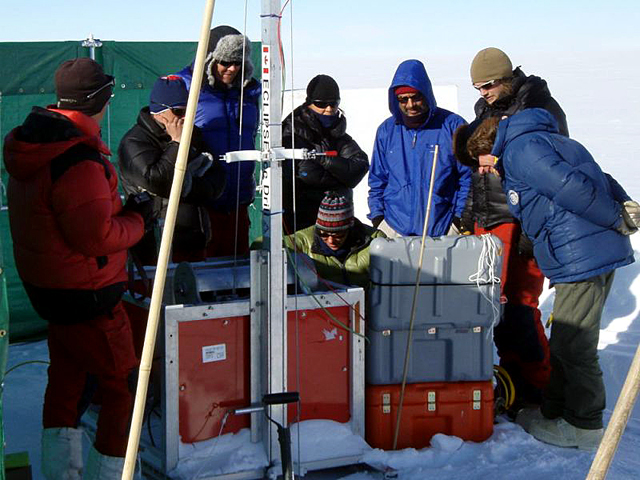IPY TraverseOverland exploration of East Antarctica collects data for last thousand years of climatePosted April 24, 2009
The 12 scientists and support staff who made a slow crawl across a vast, blank stretch of East Antarctica this past austral summer for three months to study how regional climate variability relates to global climate change expected to encounter brutally cold storms and other challenges on the high polar plateau. They didn’t expect to come across other travelers in the relatively unexplored area known as Queen Maud Land. But they did — three times in one day. “We were astonished because we were supposed to be all alone,” said Ted Scambos The encounters, all involving people taking part in a commercial race to the South Pole, occurred near a fuel depot in an area where the ice sheet was more than 3,000 meters thick, hiding at least four distinct subglacial bodies of water called the Recovery Lakes. 
Photo Credit: Ole Tveiten
Non-government vehicles, left, appear out of the nothingness of the polar plateau.
“Fuel depots in Antarctica are kind of the equivalent of watering holes in Africa,” mused Scambos, lead scientist at the Boulder, Colo.-based National Snow and Ice Data Center But for most of the roundtrip journey between Norway’s Troll research station on the coast and the U.S. Antarctic Program’s South Pole Station Living and working out of bright red, boxed buildings mounted on sleds, the team collected ice cores at various depths and locations, used radar to map the ice sheet layers and dug snow pits — all in an effort to understand the climate in this area for the last thousand years and how it may be changing today. The project was part of the International Polar Year “It’s really been a blank spot on the map — on both the literal map as well as the metaphoric map of climate change in Antarctica,” said Tom Neumann 
Photo Credit: Lou Albershardt
The traverse team attempts to recover a stuck ice core drill, which they later did.
Scientists had believed that Antarctica was largely bucking the global warming trend. While West Antarctica was undoubtedly heating up — particularly the outstretched tip of the Antarctic Peninsula where ice shelves are disappearing at historic rates — studies of the much larger East Antarctic Ice Sheet suggested a cooling trend. Some researchers have suggested the depletion of stratospheric ozone over Antarctica — the ozone hole that appears each austral spring — is affecting atmospheric circulation and westerly winds around the continent, effectively shielding it from global warming. But a paper in the journal Nature earlier this year said warming in West Antarctica is greater than whatever cooling may be occurring on the rest of the ice-covered continent. “Simple explanations don’t capture the complexity of climate,” explained Eric Steig “The thing you hear all the time is that Antarctica is cooling, and that’s not the case,” added Steig, a collaborator on the IPY traverse project. “If anything it’s the reverse, but it’s more complex than that. Antarctica isn’t warming at the same rate everywhere, and while some areas have been cooling for a long time, the evidence shows the continent as a whole is getting warmer.” Antarctica is roughly the size of the United States and Mexico: Snow in Denver doesn’t mean a blizzard stretches all the way down to Mexico City. “Antarctica is a huge place, and I would be surprised if it was all doing the same thing,” said Neumann, a scientist now with NASA Goddard Space Flight Center Yet there’s even a hint that East Antarctica — well, at least one spot on that incomplete map — may be warming based on one initial experiment by the traverse team. Scambos deployed strings of highly sensitive “thermometers” called thermistors into two of the deeper ice core holes. The temperature on the ice sheet surface changes with the weather, but the temperature deeper down changes very slowly as the climate changes. Neumann likens it to throwing a frozen turkey into the oven — not the best way to cook a turkey, for sure, but eventually the center starts to thaw and cook based on the long-term outside temperature. “It takes a while for the ice at 90 meters to notice how the surface temperature has changed,” Neumann explained. At that depth, the ice temperature is determined by the average temperature of the last 50 years or so. The instruments will operate for the next several years, allowing the scientists to determine how surface temperature changes through time. “The initial results do say these areas are warming,” Neumann said, stressing that the measurements are in the hundredths of a degree per year and the data still raw. 1 2 Next |



For USAP Participants |
For The Public |
For Researchers and EducatorsContact UsU.S. National Science FoundationOffice of Polar Programs Geosciences Directorate 2415 Eisenhower Avenue, Suite W7100 Alexandria, VA 22314 Sign up for the NSF Office of Polar Programs newsletter and events. Feedback Form |


